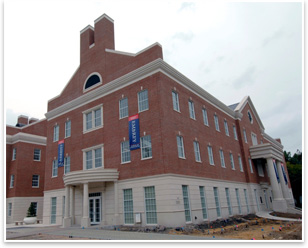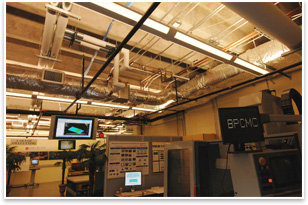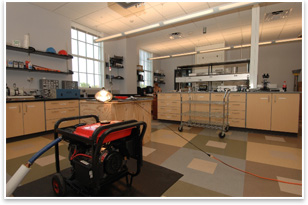
Green SMU Engineering Building Is Teaching Tool Summary: A new building for engineers on Southern Methodist University’s Dallas campus is helping to educate classes of sustainability-savvy practitioners. SMU’s Embrey Builiding, the first university building in Texas built for a LEED® Gold rating from the U.S. Building Council, embodies a teaching tool that offers students lessons on sustainability in its every nook and cranny. Architects Hanhfeld Hoffer Stanford collected LEED points even while designing in SMU’s Collegian Georgian style. The building already is saving the university 30 percent in energy and water costs over another campus engineering building constructed just four years prior.
Nearly all of the building materials came from within a 500-mile radius of SMU, and more than 75 percent of the construction waste was recycled rather than ending up in a landfill. It includes more than 30 miles of data wiring, two distinct water systems, and the latest in high-tech research equipment.
The engineers built a tremendous amount of instrumentation into the facility so they could track almost every operational detail in the building at any given time, making the data collected available to the students. “We track that not only from an educational point of view, but an operational point of view because we like to be able to report the level of water and energy savings. We even track how much sick time employees are using relative to other older buildings on campus. The whole building itself is not only a laboratory, but it is the experiment itself,” Orsak enthuses.
|
||
Copyright 2006 The American Institute of Architects. All rights reserved. Home Page |
||
news headlines
practice
business
design
recent related
› LEEDing by Example: AIA Honolulu is the first to achieve Gold LEED-CI in Hawaii
› California Academy of Sciences Evolving Green
› AIA COTE Selects Top Ten Green Buildings for 2006
Hahnfeld Hoffer Standford received the Texas Society of Architects Firm Award in 1997.
In addition to other major donors, including the building namesake J. Lindsay Embrey, an SMU alum, the Kresge Foundation has made a commitment of up to $850,000 to the Embrey Building. This includes a $600,000 challenge grant contingent on SMU's success in completing funding for the $15.9 million building by December 31, 2006, while also doubling the number of donors contributing to the project.
A printer-friendly version of this article is available.
Download the PDF file.




